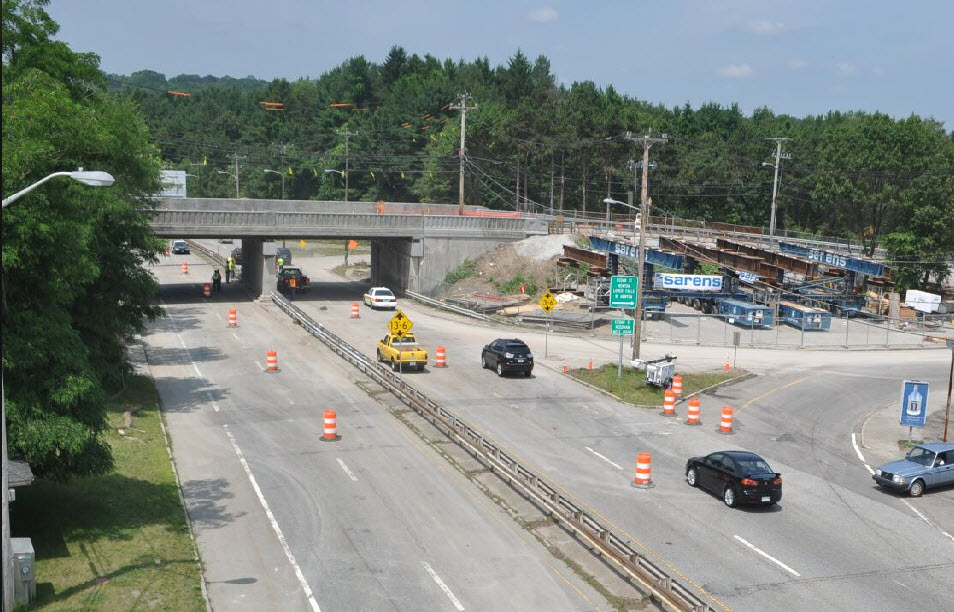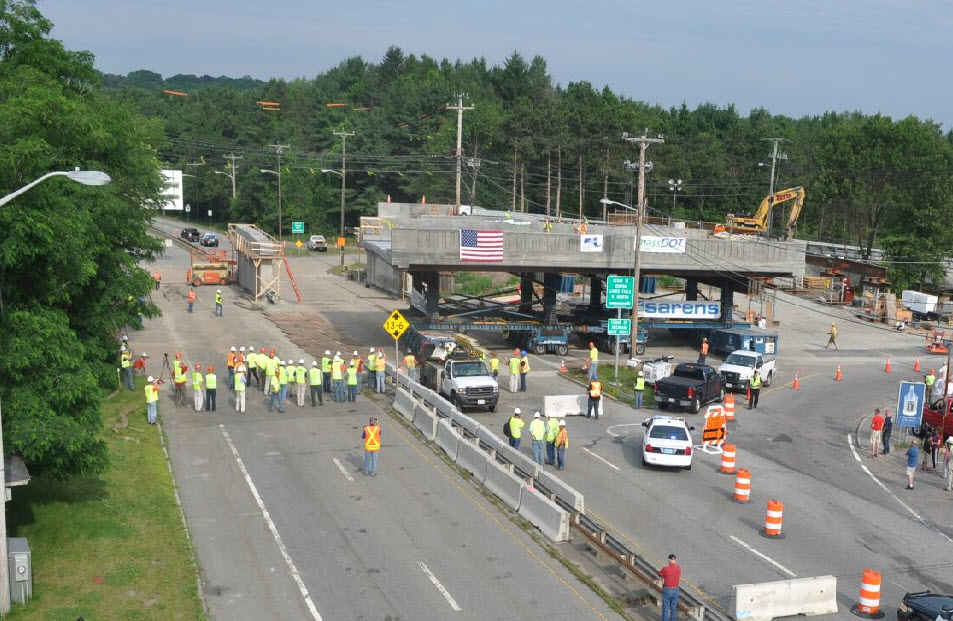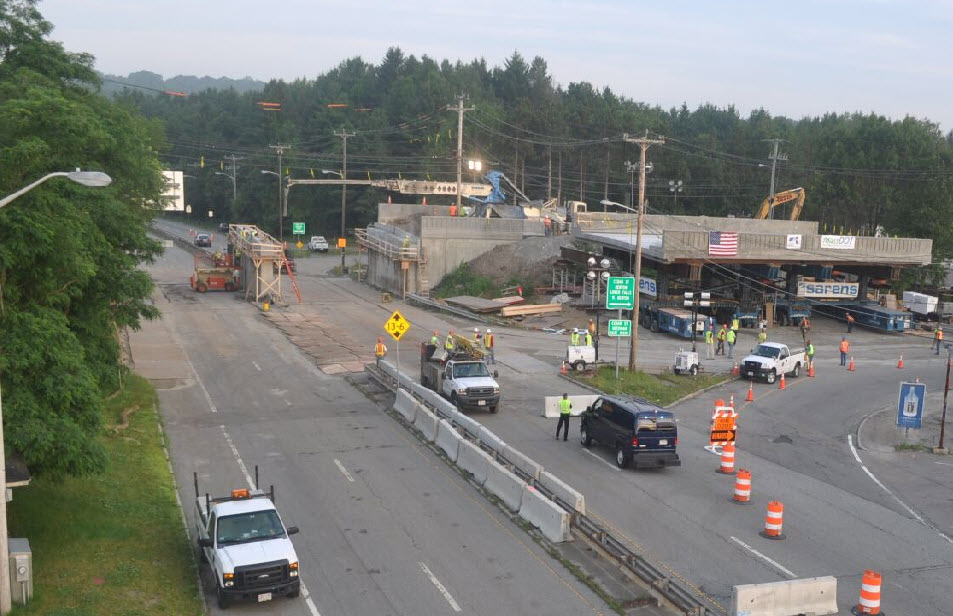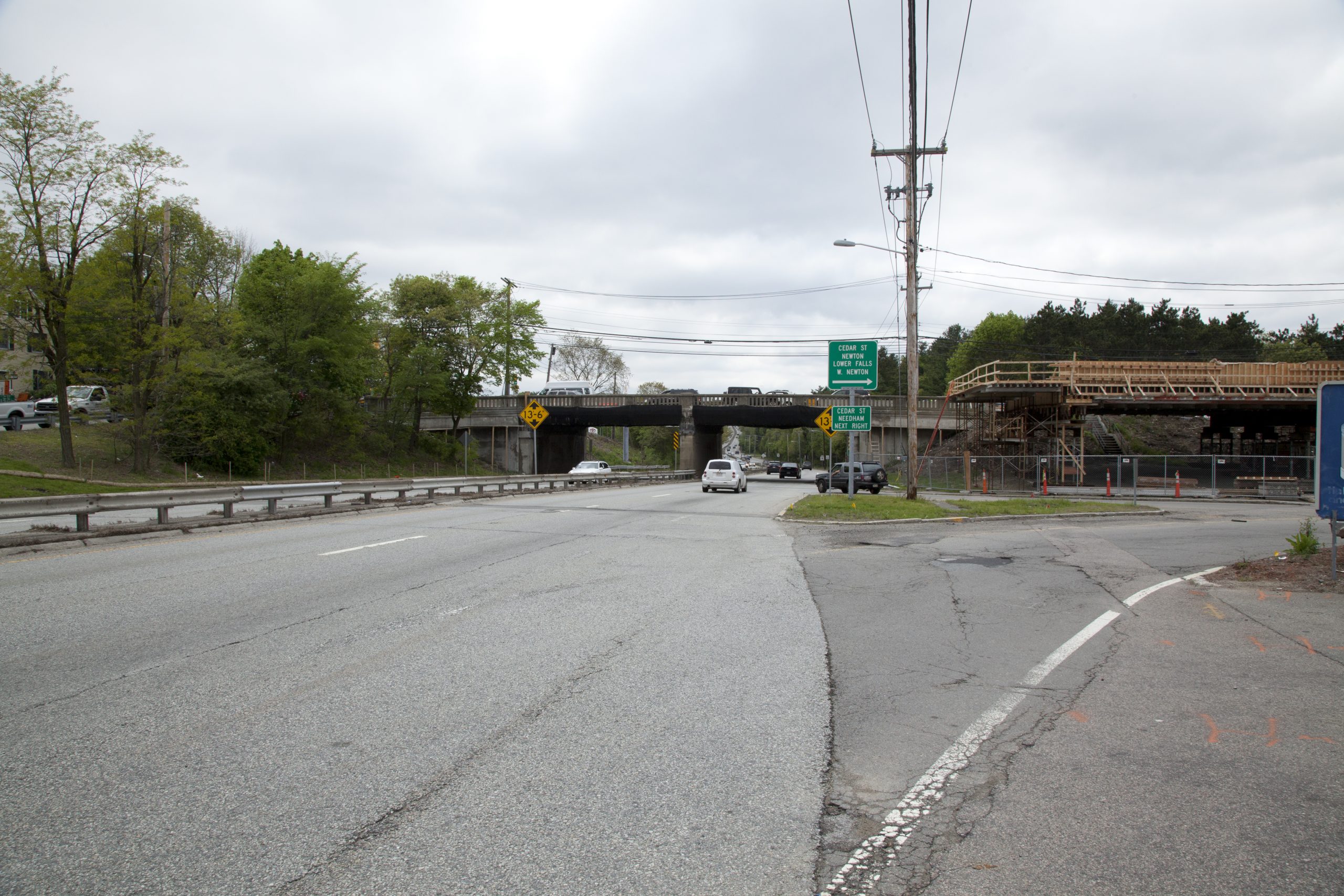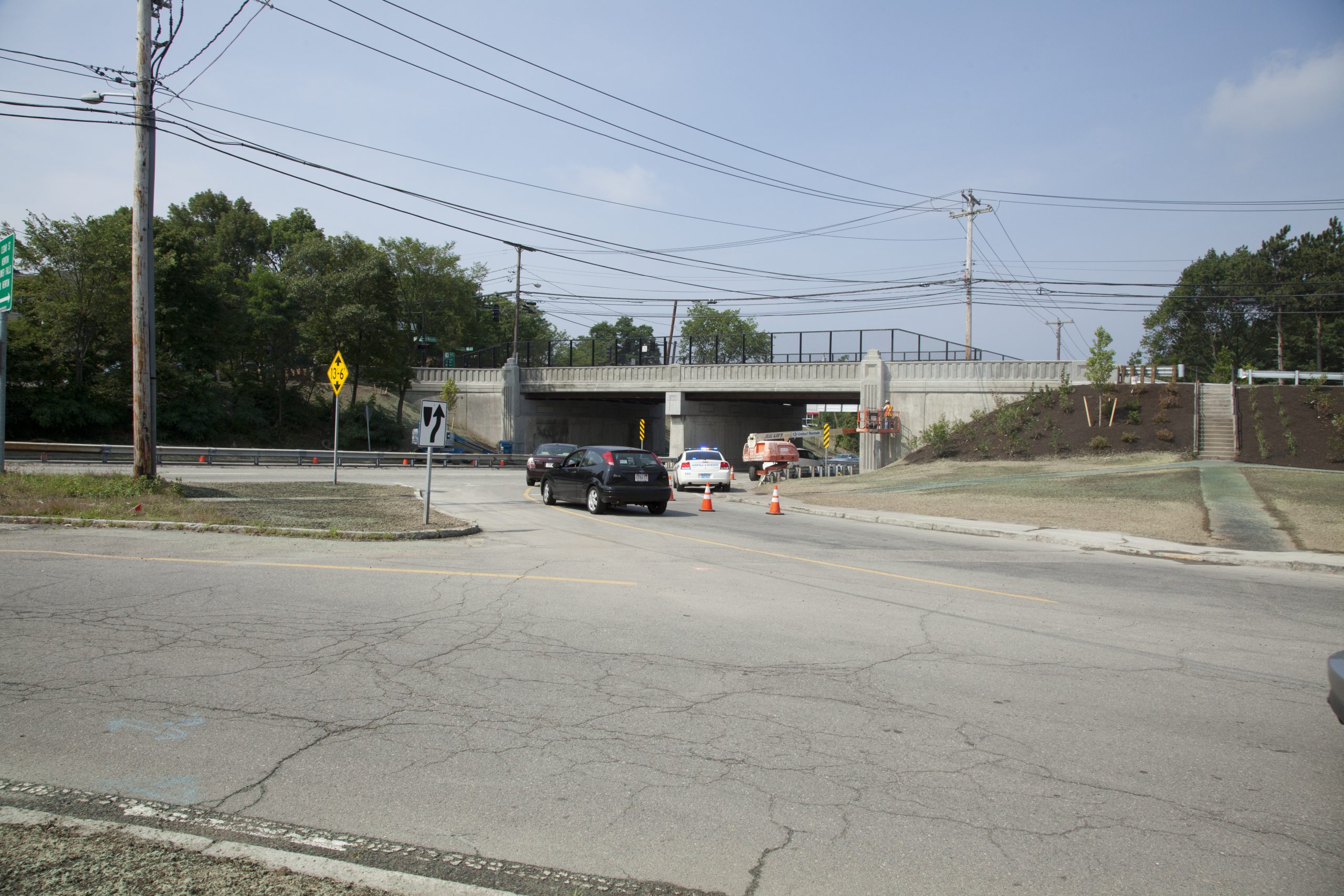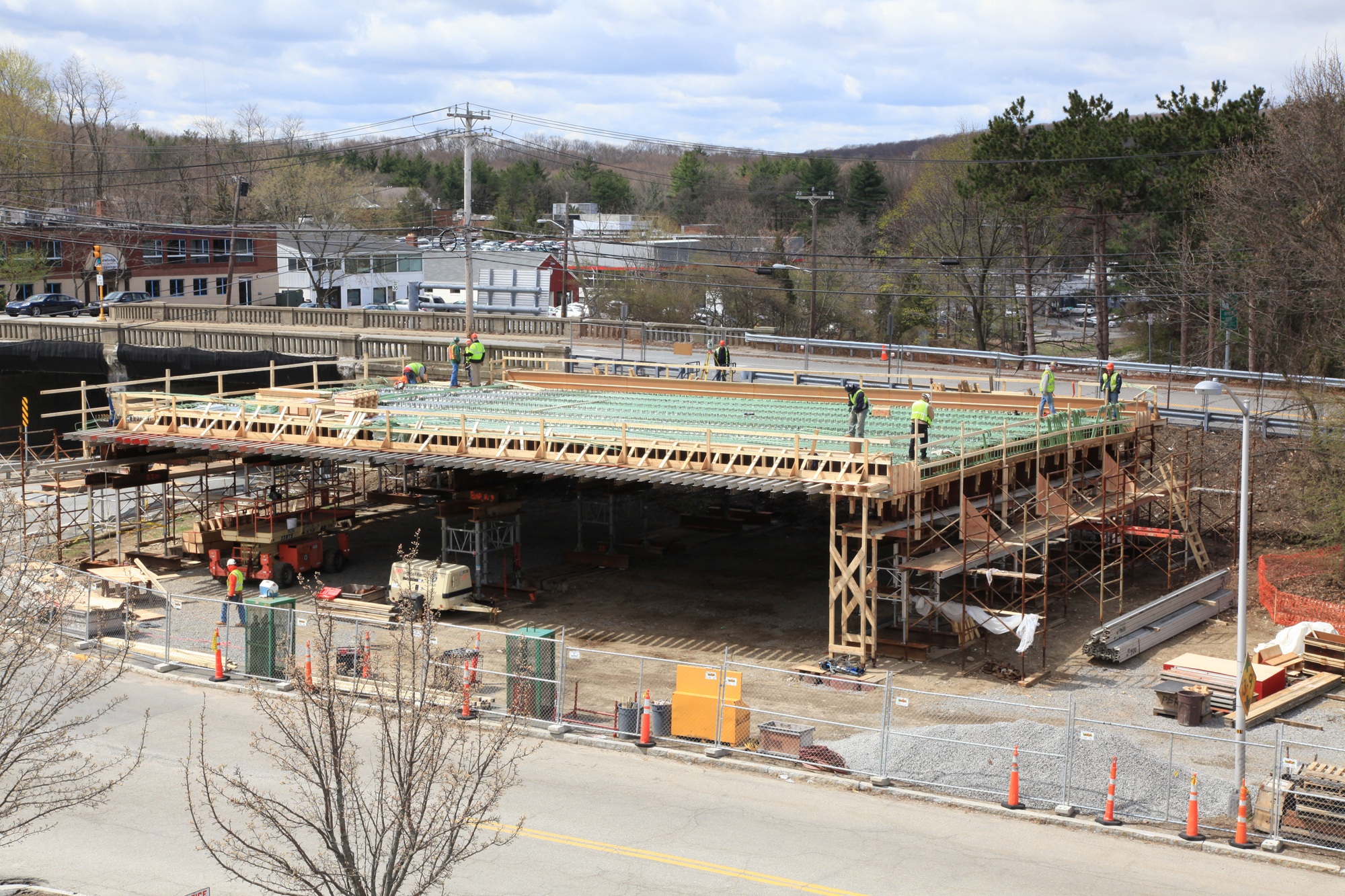State: MA
County:
Owner: State
Location: Urban
Spans: Two-span
Beam material: Steel
Max Span Length (ft.): 41.54
Total Bridge Length (ft.): 83.08
Construction Equipment Category: SPMTs
ABC Construction Equipment: SPMT(s); High-capacity crane(s)
State ID Number: W-13-015
NBI Number: W13015-2MH-DOT-NBI
Coordinates
Latitude: 42.3154945 | Longitude: -71.2471085
Bridge Description
Project Summary:Project Location:
Cedar Street (urban minor arterial) over Route 9 in the town of Wellesley in Norfolk County, just west of the I-95/9 Interchange and west of Boston
Impact Category:
Tier 2 (within 3 days)
Mobility Impact Time:
ABC: One weekend closure (72 hrs); 30 days of night or off-peak one-lane closures on Rte 9; Conventional: 24 months; two construction seasons
Primary Drivers:
reduced traffic impacts, reduced onsite construction time, improved work-zone safety, improved site constructability, improved material quality and product durability
Dimensions:
83.08-ft-long and 53.33-ft-wide two-span continuous steel girder bridge roll-in (41.54 ft – 41.54 ft); 7º skew; 530-ton self-weight
Average Daily Traffic (at time of construction):
12184
Traffic Management (if constructed conventionally):
Traffic management alternative, if constructed conventionally: extended use of detours through city streets
Existing Bridge Description:
Built in 1932, the existing two-span two-lane steel girder bridge was structurally deficient and had a minimum vertical clearance of 13.75 ft. The superstructure was in poor condition and needed to be replaced, but the pier and abutments were able to be repaired, adjusted, and reused.
Replacement or New Bridge:
The replacement bridge has three traffic lanes, one in each direction with a left-turn-only lane in the southbound direction. There is a 6-ft-wide sidewalk on the east side of the bridge and a 5-ft-wide sidewalk on the west side. The 2.17-ft-deep cross-section consists of 8 steel girders (W14x159) at 6.75-ft spacing with 8-inch-thick composite cast-in-place concrete deck and 3-inch-thick hot-mix asphalt (HMA) wearing surface. To avoid future truck collisions, MassDOT increased the bridge’s vertical clearance to 15 ft.
Construction Method:
The contractor built the replacement bridge on temporary shoring towers on site within the east cloverleaf ramp north of the bridge. At 10 pm on Friday, July 1, Cedar Street and Route 9 within the work area were closed and traffic detoured. The contractor demolished the old bridge and erected new precast abutment caps, a new precast pier cap, and elastomeric bearings. At 5 am Sunday, four lines of self-propelled modular transporters (SPMTs) moved the superstructure from the cloverleaf onto the Cedar Street ramp and down the ramp onto Rte 9, arriving at the pier and abutments at 9:30 am. The SPMTs lowered the bridge into position early Sunday afternoon. The contractor then worked to put temporary lane markings in place and open one sidewalk for pedestrians. The bridge and Rte 9 were reopened at 12:00pm noon on Monday, July 4. The holiday weekend was selected due to historically low traffic volumes. The remaining work, including installation of architectural pilasters and completion of sidewalks, was done subsequently during off-peak hours.A membrane system was applied to waterproof the deck prior to moving the bridge. Five windows were left in the membrane to monitor for cracks during and after the bridge move. After the bridge was moved, the five windows in the waterproof membrane were covered and the HMA wearing surface was applied.There were four milestone incentives/disincentives used for this contract. Milestone 1 involved having all construction plans approved, the bridge fully constructed in the clover leaf and ready for the move, all traffic management plan measures in place and ready for deployment and the SPMTs on site by July 1, 2011. A $50,000 incentive / disincentive was associated with this milestone.Milestone 2 was demolishing and replacing the Cedar Street Bridge on the 4th of July weekend within 72 hours. There was a $2,500 per hour incentive / disincentive to a maximum of $150,000Milestone 3 was substantial completion by July 20, 2011 for a $50,000 incentive/disincentive.Milestone 4 was Final Acceptance by August 20, 2011 for a $50,000 incentive / disincentive. This milestone was revised to allow only the evergreen trees to be planted by September 30, 2011 for the evergreen planting season fell after the August 20, 2011 date, although all other parts of this project were still to be completed by August 20, 2011.
Stakeholder Feedback:
Feedback from local residents and stakeholders was very positive, due to maintained mobility during construction and strong education/outreach prior to the move weekend.
High Performance Material:
High performance concrete (HPC) deck
Project Planning
Decision Making Tools: State process, Benefit/Cost MethodSite Procurement: Right-of-way acquisition, Electronic shop drawing submittal & approval process
Project Delivery: Design-Build
Contracting: Full lane closure, Incentive / disincentive clauses, No Excuse bonus, Lump Sum bonus
Geotechnical Solutions
Foundations & Walls:Rapid Embankment:
Structural Solutions
Prefabricated Bridge Elements: Precast column cap (precast bent cap; precast crossbeam), Precast abutment capPrefabricated Bridge Systems: FDcBs (Full-width concrete-decked steel beam
Miscellaneous Prefabricated: CIP reinforced concrete closure joint, Bars in splice coupler, Asphalt overlay w/membrane, Precast approach slab
Costs & Funding
Costs:The engineer’s estimate for the project was $3.45 million. The actual cost was $3.45 million plus $175,000 in incentives and $123,000 in police details. The cost per square foot of bridge was $831.40.
Funding Source:
State Only
Incentive Program:
Additional Information
Downloadable Resources
Contract Plans: View 100-Stamped-Bridge-Plans.pdf
View 100-Stamped-Civil-Plans.pdf
Bid Tabs:
Construction Schedule:
View Contractor-Schedule-Update_08-15-11.pdf
View Baseline-Schedule-Rev01.pdf
Other Related Information:
MassDOT-ABC-Decision-Chart_2009
Summary Sheet:
120808-ABC_New2_MA_2011_Cedar-Street-Wellesley
Other Related URLs:
Go to:
http://www.massdot.state.ma.us/abp/Projects/WellesleyBridge.aspx
Go to:
http://www.youtube.com/watch?v=jZ7FjwSYXEA
Go to:
http://www.flickr.com/photos/massdot/sets/72157625631453339/
Go to:
http://articles.boston.com/2011-07-04/news/29736535_1_new-bridge-bridge-project-bridge-friday-night
Go to:
http://wellesley.patch.com/articles/new-bridge-is-new-milestone-for-wellesley
Go to:
http://www.wickedlocal.com/wellesley/news/x941157302/Governor-Patrick-tours-Wellesley-bridge-project-site#axzz1iQnyCYYs
Massachusetts Department of Transportation
Contacts
Shoukry Elnahal,
P.E.
Deputy Chief Engineer for Bridges and Tunnels
Massachusetts Department of Transportation
shoukry.elnahal@state.ma.us
617-973-7995



